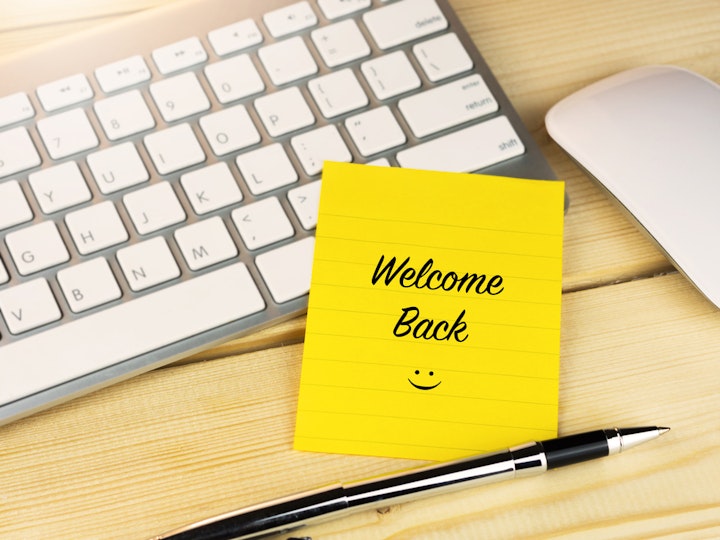Return to work means focus on creativity, collaboration and caring - and AI
What does a successful return to the office after the pandemic look like? Dr Naeema Pasha explores for Leading Insights.

Many people say there is no new normal and we will go back to the old days before lockdown. I disagree, because work has changed for almost everyone. The pandemic has made us all re-think about the ways we go about our jobs.
Ahead of us as we return to workplaces, we will face many concerns over lockdown effects, such as anxiety, workload, mental health and isolation, which we will need to address as the consequences are still to play out.
However, many workers have outlined huge positives that lockdown has enabled. The reduction in commuting, greater flexibility and informal working, as well as more time with family has been hugely welcomed. A recent poll on Twitter showed that while many workers said they missed seeing colleagues in person, only 10% of workers wanted to go back into 100% workplace-only working, with the majority (58%) saying they wanted a job that offered a ratio of 80% remote to 20% office-based work. This highlights that for so many, flexible and autonomous working is a big desire.
But what if a major shift to more flexible working was made possible, how could we do it well? I believe it will be possible by harnessing AI coupled with a major re-focus on people skills in the workplace.
At the very least, the lockdown experience has taught us that our ‘new normal’ work should not involve being stuck at an office desk in silence filling data spreadsheets all day long. Instead, as many commentators are saying, workplaces should best be used for human interactions. My view is we focus on creativity, collaboration and caring as the priority skills to use in a physical workplace. These are the human skills that can’t be done as well on a Zoom call. Coincidentally, these are skills robots can’t do either (but they can do data faster than we can).
Creating social glue
We've also found we need people. Our recent experience during the pandemic was of another human crises – inequality. For example, in facing the challenges of racism, the Black Lives Matter movement surfaced, and many organisations scrambled to respond and support employees.
Lockdown highlighted that when staff experienced traumas, not least from the impact of COVID-19, managers found it harder to be as supportive online as they would have in person. So, while some companies have started cancelling city office spaces, they might be jumping the gun. As a species, we humans still have a primal necessity to be with our ‘troop’ and we require face-to-face interaction to show we care (and to be cared for) and to be able to collaborate with them. While we have a need for autonomy, we also have an innate need to belong, and a sense of identity – a workplace fulfils some of these needs.
Many studies show that reduced face-to-face interaction reduces the production of oxytocin, the hormone we produce to build trusted relationships and drive pro-social behaviour. So remote-only teams that meet up occasionally in a hotel or collaborative WeWork type space, might find it harder to form bonds and build trust from other team members.
We need to also remember that for some, workplace ‘fun and enjoyment’ interactions are motivational, but harder to replicate online. This need might possibly rank higher with younger generations who, in just joining the workforce, need to establish bonds and new work identities.
Our recent work in Henley on generational differences found even though Gen Z, who have been raised in an ‘always on, always connected environment’ and favour the ability to choose their own technology as a driver of where they want to work (66%), they also said they like working in workplaces: more than three-quarters (77%) believe that an office with great facilities for work and leisure is important.
Reshaping office life for the better
AI is coming and will impact our work and workplaces, but we need to think ahead on its application to ensure clarity and transparency. A report from the OECD’s 2019 report states that 32% of jobs will change radically as the result of automation in the next 15-20 years. I believe this will now be shorter because of the experience of COVID-19.
However, the recent CIPD’s report on workplace technology, which covered a cross-sector survey of 2,500 employees from June 2019 to June 2020, showed however, that many employees are not aware that AI and automation is on the horizon, stating that:
- 72% of employees feel it unlikely that their jobs will even be partly automated;
- 93% of employees had never used automated systems;
- 35% of employees had never been consulted when new technology had been introduced;
- 28% of employees faced with automation had received training to prepare for the change.
We need to consider how AI could enable better work and not just focus on the efficiencies it provides. Many of us have become more used to video conferences, perhaps feeling a little more tech-savvy now, so, it is an ideal a time to look further adoption of AI technology to facilitate the workstyles and work-culture we want. For example, by deploying AI systems such as Robot Process Automation (RPA) to do more repetitive tasks (those data-heavy sitting in silence at a desk tasks), we can plan how we free people to refocus on useful and essential human work.
We want people to be with each other (face-to-face some of the time) to create and build ideas, problem solve, look after each other, chew over the big and small issues – all the things that make work more innovative, meaningful, and productive.
To create better workplaces, we should remember what positive lessons the pandemic has taught us: remembering how we loved the flexibility and freedom it gave, and how much we want to retain it.
But we also need other people for our creativity, collaboration and caring needs. If we get this balance right, it means we can perform and enjoy work better. I feel if we think wisely and constructively about AI deployment, we can ensure people can find ways to connect more purposefully to the ‘new-normal’ of workplaces.
You might also like
Why WeWork didn't work - the demand for co-working spaces
Is staycation inflation here for good?
Students invited to take part in experimental VR learning experience
This site uses cookies to improve your user experience. By using this site you agree to these cookies being set. You can read more about what cookies we use here. If you do not wish to accept cookies from this site please either disable cookies or refrain from using the site.
